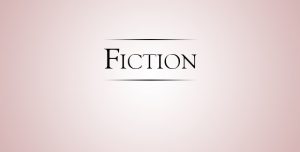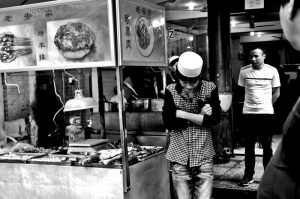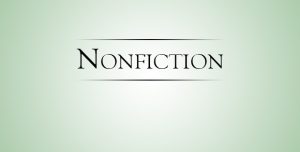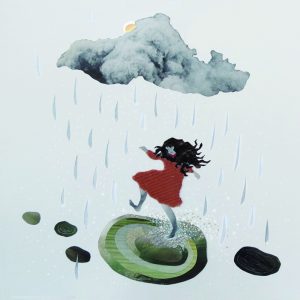Peter Imsdahl

(Frog Walks Into a Bar)
“Why do they jump?” Paul asked, fingering a twig he had picked up from the forest floor on their way to the clearing, a swath of forest cut clear of trees, seemingly just for them. There was a fallen log in the middle of it that they could both sit on and dangle their legs from, letting the sun’s rays shine a clemency upon them as they talked of the verities.
“Guys my age (double digits now that I’ve recently put a wrap on fifth grade) are noticing girls in a different light (one or two are growing breasts). And though nobody in my class has kissed any of the girls he likes, we don’t really need to clobber any of them anymore either.” (They don’t like it.) Paul had developed, after school let out for the summer a month ago, a habit of talking with his right hand stationed vertically at the left side of his mouth. It was an aside, he told his dad. Miss Billings had mentioned this when they were discussing plays.
“Actors sometimes do that when they want to comment to the audience,” and here he quoted Miss Billings verbatim, “‘in a poignant, sarcastic or otherwise knowing way.’” Paul added that it was kind of like speaking in parentheses.
“They jump,” Mike said, with an answer that was half guess and half common sense, “in order to escape from predators, usually into the water, I would guess, from the shore.”
They had been talking about frogs, or anurans as Miss Billings called them when she addressed the topic in biology earlier that spring. She had taken them through the obvious aspects: tadpoles, the slowed heartbeat during winter hibernation, and even the non-mainstream aspect of the urine of a pregnant woman being injected into a mature female frog, causing it to lay eggs within a few hours. Here, according to Paul, Miss Billings had crossed and uncrossed her legs more than once, as if nervous.
“Is there such a thing as an accidental predator?” Paul asked, his face warmed by an early July sun. Mike could see where this question had come from. Trish, his late wife, had been severed in two when the car of a drunk ran into her as she was attempting, at an intersection, to pour a cannister’s worth of gas into her tank. The old Plymouth’s tank hid its gas access just under the rear license plate. The gas gauge on the car had broken and the two of them managed to keep the tank relatively full, or at least had a pretty good feel for when it was close to empty. She used to liken it to pulling the pot of warming milk from the stove just before it scalds. At the time of the accident, she was three months pregnant with Paul’s would-be sister; Paul was almost four.
Read More . . .
“There are people who don’t mean to do what they do, but predator kind of implies a willful intention, that there is a plan, that a hungry lion wants a leg of zebra, or a fox a pheasant.”
Apropos of intention. Mike thought, just then, of something he had read that morning. “Somatic Intention Precedes Conscious Thought by 1/3 Second,” the article title had read.
“They say that our muscles, our bodily functions—no, our movements—can take place before our brain even sends the message.”
“You mean we can do something before thinking about it?”
“Not exactly, not that completely, but sort of.” He could see that Paul was busy with this.
“Well, wouldn’t that be an excuse for almost anything?” Hand to the side of his mouth. (You could tap a girl on the shoulder, then say it happened before you had a chance to think about it.)
“Theoretically, but that’s not what they mean. They were perhaps trying to find a way to say that muscles are thinking on their own—in response to a situation, say.”
“Like a frog jumping into water?”
“I suppose. Yes, like that.”
“Like, because the frog has experienced that dangerous situation so many times—like the threat of a snake—that because he senses the danger, his jump muscles carry him away from it before he actually thinks to?”
“Sounds about right, Paul.”
“So where does that put Mom?”
“What do you mean?”
“She never had the situation to learn from, never had the near misses like the frog and the snake. If she’d had practice reacting to a car trying to cream her. . . .”
Mike put his arm around Paul in order to pull him closer. In public, lately, Paul seemed to be growing averse to such affection. Here in the clearing, however, away from everything and everyone, he seemed not to mind, perhaps even to relish it. They were both quiet for long enough to see tree shadows grow.
“Miss Billings said that in nature it’s survival of the fittest and that if the snake eats the frog, the frog was not meant to survive beyond that moment.”
“This is different, Paul. Your mom was meant to live beyond that moment, that day. The car didn’t win anything for having . . . ” His voice trailed off. Paul tossed the twig to the ground, raised his hand for an aside. (Yet the car is still driving around, and she isn’t.)
“Your mom used to love a walk in the woods.” When he realized how ordinary that sounded, how intangible, he added that once, when the two of them were on such a walk, “just before you were born and it was late summer, she bent down, kind of sideways because she was out to here with you.” He looped his arms out over his lap is if to form a human basketball hoop. “And she said, Will you look at that? and pointed at something growing out of a dead log. Two things I remember about that moment: that she used her index finger to pull the thick strand of hair out of her face and behind her ear, and that she had the most attractive jaw line, one that an artist would have used as a focal point in a painting. She had a stunning beauty, Paul, that would have melted the faces from Mt. Rushmore had they but caught a glimpse of her that day.”
That evening Mike perused the encyclopedia so that he could be ready for the next sitting in the clearing. Under “frog,” he found out that they generally return to open water for breeding, that the frog call serves to call the population together, establish territory for each male, and to attract females. He found out that the breeding male will clasp onto any female that comes near.
“Well, duh.” And when he read that male frogs can distinguish female frogs by their plumpness, he thought of Jill, the woman in the office two floors down from his. They’d had a couple of dates; she had a penchant for vegetable shakes, Greta Garbo movies, and for the way he touched the back of her neck lightly with his fingertips when he talked with her. Rather suddenly, he stopped seeing her. It wasn’t because they were of two different political leanings. That he could handle. It was that he wasn’t sure if she would be kind enough to Paul.
Jake, a neighbor two houses down, had commented that it was “not good practice to buy your meat and your bread at the same store—if you get my drift.” Mike wondered why he let that bother him. He liked Jill and they seemed to get along. Perhaps Jake, single himself, was jealous. Nonetheless, he hadn’t spoken with Jill in ages.
When he read that the discharge of eggs bounces against the cloaca, stimulating his ejaculation of milt, he closed the volume.
Their next afternoon in the clearing brought a slough of questions from Paul.
“At the end of October,” Mike answered, “the meadow frog searches for shallow, still water, and hibernates in the muck, often in the company of as many as 500 other frogs.”
“Miss Billings said that during hibernation he breathes only through his skin.”
“Eight minutes,” said Mike as Paul scooted a little closer on the log, “is the longest a frog can hold his breath under water. Imagine what it would be like to hold your breath for a whole winter.”
Paul sucked in a breath and held it. He let it out after thirty seconds.
“Imagine,” said Mike with a chuckle, “the last breath you take, before your long winter sleep, is some bad air.”
(A frog fart, perhaps?)
“That.”
“They eat scads of insects, Miss Billings told us.”
“Myriad.”
“Myriad?”
“It means thousands. It’s like scads, only wiser.”
“And yet all it takes is one hungry heron.”
“Or a grass snake,” offered Mike. As he put his arm around Paul, he had the impression that Paul was growing an inch per week.
“Yes,” sighed Paul, “a grass snake in a Catalina.”
Mike hadn’t remembered informing Paul about the make of the car that had killed Trish. There was a silence in which they heard a cuckoo.
“The accuracy of the tongue,” Mike quoted now by memory from the encyclopedia, “leaves something to be desired. But since their environment is loaded with insects, it doesn’t matter.”
“Miss Billings said that the tongue was twice as long as the frog itself.” Paul reached down to the forest floor and picked up a stone that he then launched at an oak, hitting it squarely in the trunk.
“Dave O’ Brien, a guy in class, said something about a French kiss and Miss Billings went red. She gave him those fatal eyeballs and said, And David shall keep such comments to himself.”
Mike smiled.
“Dave told me later that that’s what two people did when they were kissing. A kind of polishing each other’s tonsils.”
Mike tipped a little back and forth on the log, uncomfortably. He thought about how it was, kissing Trish. When they first kissed with open mouths, it had been as if she had released an electric eel into his mouth, one that wanted to wriggle right down his throat.
“Could be,” he acquiesced.
(Meaning yes, our hero had undergone such horrors, but is too embarrassed to talk about it.)
“Did you know that toads can wander almost half a mile to a pond in order to lay eggs?” Mike said, changing the subject.
Silent Paul.
“Before school let out, we read haikus in English. Do you know what that is?”
“I know it’s comprised of three lines.”
“Comprised?”
“It’s like composed, but from a different word shelf.”
“OK. But anyway it’s five, seven, five—the number of syllables. Five in the first, seven in the second, etc., and the subjects are nature, peace, and whatnot.”
“And frogs?” asked Mike.
“Did she have you write any?”
“Naw, but I wrote one anyway.”
“Could I see it?”
“I tore it up. It wasn’t any good.”
“Who’s to say?”
“Well, I guess I am, since I’m its creator.”
“What do you say you write another?”
“About Mom?”
“Was that one of the official haiku themes?”
“Probably not.”
“Then try frogs, anurans.”
“OK. But let’s both write one and then, when we’re finished, show each other.”
“Deal.”
Before the next meeting in the clearing, Mike prepared by gleaning everything he could from an old biology book he had found in the attic. Paul seemed momentarily impressed by Mike’s talk of the tree frog.
It was a cloudy afternoon, one cool enough to warrant light jackets. “When falling, the tree frog can spread its limbs in order to increase its surface area and thereby break its fall.”
“Like a flying squirrel,” Paul chimed, bright with smile.
“Whereas the terrestrial frog,” Mike continued, “that is, the common anuran, when dropped from a high place, wriggles and squirms in panic, falls like a rock.”
“How do they know that, Dad? Do they drop them from high places, say, Oh, that one wriggled and squirmed—and SPLAT!—must be a regular frog?”
“Probably something like that,” he conceded.
“Your poem ready?” Paul asked with beseeching eyes.
“Not yet.”
“Mine either. Did you know that they have only four fingers on each hand?”
“Didn’t know that.” He indeed read quite a bit about frogs, but hadn’t remembered coming across that. “They wouldn’t be able to hitchhike.”
Three days later, they were sitting on the log when Mike offered that frogs were cold-blooded animals.
“Cold-blooded? Isn’t that like murderous without having regrets?”
“Remorse?”
“Is that no feelings for the victim?”
“I guess so,” said Mike. “But in this case, with the frogs, it means that their temperature fluctuates with that of the environment. That is, they’re not like birds who can regulate their temperatures internally. When the water grows colder, frogs grow sluggish.”
“Clobberish?”
“No, slow.”
“Is that when they start looking for places to spend the winter?”
“It is.”
“Miss Billings said that frogs drink through their skin. Hey, wouldn’t that be something? A frog walks into a bar. The bartender says, What’ll you have? The frog says, I’ll just climb into a glass and you pour whiskey and water over me. Carbonated? No, thanks, says the frog, I’ve never been one for jacuzzis.”
Mike smiled. Then he offered, “Did you know that some females hear only the call of the males in their own species, and that in some species the call has been lost and the male has to actively search for a female?”
“Like you?”
“Like me?”
“As in, you aren’t croaking much of a song for the female species. I mean, except for that woman at the company picnic two summers ago and then maybe Jill.”
“I don’t know. It doesn’t seem to fit into my life right now.”
“You mean the breeding part?”
Mike went silent, shifted his legs on the log.
“Isn’t Jill the one who left the little pink thong in the bathroom?”
“You found that? Er, I mean she was looking for that—”
(Defendant wishes he had pled The Fifth.)
“I guess that that piece of mini-underwear was hers,” Mike laughed to himself.
They were both quiet for a minute or two. When a pheasant call broke the silence, Mike said that the most fascinating thing about frogs is their orientation.
“Oh, I know. Miss Billings said something about that in our Sex Ed hour. Something about a person’s sexual orientation.”
“No, not that. I mean their ability to aim, to find their way.”
“Like they do after a long winter? When they’re looking for water?”
“Yes, and they say that, to orient, frogs use a kind of sun-compass sense. That they orient themselves towards the shoreline, point their noses to it, and that frogs on land orient towards—”
“—The water.”
“Exactly. And here’s something else. That when they are sitting on the shore, given the choice, frogs will jump towards blue more than any other color.”
“Towards the sky?”
“Therein lies the magic of it, son. Towards the sky as reflected in the water. That sense gets them into bodies of water that reflect the sky.”
“I think she’s listening for your frog song, Dad.”
“Miss Billings?”
“No, Jill.”
School would be starting in less than a month, and already Paul had organized his school things. Mike noticed that, in general, Paul had been keeping a tidier room. One day, not long before Labor Day Weekend, Paul announced that he would bring his haiku to the clearing.
“Is it ready?”
“It’s been ready for some time, but I just wanted to be sure it was good enough. That it didn’t, you know, merit any changes.”
“Merit is good,” said Mike.
“How is yours?”
Mike had begun to work on it a week or two back, but had since let it slide. He saw, now, that this haiku challenge was truly more than a whim of Paul’s.
“I’ll have mine here tomorrow,” he said, more doubtful than sure.
(Said the man, unconvinced.)
“I will.”
After Paul was in bed that night, Mike called Jill.
“Hello?” Her voice was not so much expectant as guarded.
“Hey, Jill, this is—”
“I know who it is. It’s Mike, the guy who dates you for a couple of months, takes you out to dinner and the occasional movie, invites you to his place, makes love to you like you’re the wall-mounted pencil sharpener and he’s got a number two lead pencil that he wants to sharpen right down to the eraser.”
“I think I know that guy—”
“—and then he forgets to call you.”
“Sure, I definitely know that guy. Sorry, I don’t know what my problem is.”
“If it’s your late wife, there’s nothing I can say to ease that. You’re the one who has to deal with her ghost or whatever it is standing over us in your bedroom.”
Mike was quiet, then said, “It’s that apparent, is it?”
“She’s there.”
Mike thought for a long moment about Trish, the two of them on a walk in the forest. Trish crouching to notice something.
“If it’s Paul, on the other hand, we can figure that out. He’s a good kid and I like him.”
“Would you want to see a movie this weekend?”
“Love to.”
“Oh, by the way, last time you were here, you left something. A hint: it’s pink and looks like a postage stamp bound with dental floss.”
“That’s where it went. I was wondering which guy I had left that with.” She had intended to create a little jealousy. It worked.
“Paul found it.”
“Oh.” Silence, and then, “Did he happen to find the three paste-on fingernails that I lost that night too?”
“Actually, I found those. Two under my pillow and one in my back.”
“Funny.”
“It’s good to talk to you, Jill.”
“Friday, then?”
“8 o’clock?”
“I’ll be waiting.”
On Thursday, both guys came to the clearing with something crinkling in their pockets. Paul drew his out first. “It’s only kind of a frog haiku. I guess that I was thinking about frogs at the beginning, before it turned into something else.”
“That’s what we call an objective correlative.”
“A what?”
“Objective correlative. T.S. Eliot coined it, or at least made it popular. A poem appears to be about one thing, but ultimately ends up being about something else. The objective correlative leads us to an emotion.”
“Well, so, here’s mine.” Paul handed Mike a half-sheet of paper which read:
Frog Haiku For his mom’s warm call Little Frog (if he has to) will wait the whole spring.
Mike read it twice, forgetting for a moment about his own. His throat felt as dry as a paper towel. He didn’t know what to say. Finally, he mustered a “You’re good.” And then his eyes teared a little, and all he could do was hand Paul his own poem and say, a little like a bullfrog, “Rrrreadit.”
Paul smiled. His lips moved slightly as he read the poem to himself.
Frog Haiku Choose cerulean, my dear. Whether sky, or pond— both are safe havens.
“Cerulean?” Paul asked, big-eyed.
“It’s just a fancy word for blue. I needed it for the syllable count.”
“Isn’t haven like heaven?”
“Could be.”
“Mom is in your poem too, huh?”
“I guess. Is that a surprise?”
“Nope. Are you going with Jill to a movie tomorrow night?”
“I think so. You OK with that?”
“I am.”
============================================================================
 Peter Imsdahl has published poems in The South Carolina Revew, The Iowa Review, Fiddlehead, Nightsun, The Berkeley Poetry Review, The Hiram Poetry Review, Hayden’s Ferry Review, and elsewhere. For a number of years he was a gravedigger for a small fieldstone church near the Baltic; now he is just a teacher of sorts. He is a graduate of the Iowa Writer’s Workshop and is currently seeking a publisher for his novel, Hornbückel.
Peter Imsdahl has published poems in The South Carolina Revew, The Iowa Review, Fiddlehead, Nightsun, The Berkeley Poetry Review, The Hiram Poetry Review, Hayden’s Ferry Review, and elsewhere. For a number of years he was a gravedigger for a small fieldstone church near the Baltic; now he is just a teacher of sorts. He is a graduate of the Iowa Writer’s Workshop and is currently seeking a publisher for his novel, Hornbückel.


















